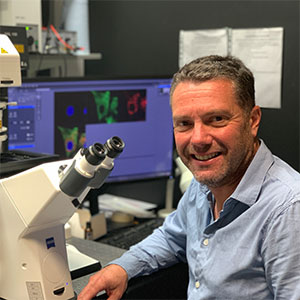Profile
ORCID iD: 0000-0003-1876-1505
Professor Paul Chapple was awarded a PhD by University College London in 1997, this investigated the physiological and evolutionary significance of Hsp70 chaperones in a marine organism. He then worked for eight years as a Postdoctoral Researcher in the laboratory of Professor Michael Cheetham at the UCL Institute of Ophthalmology, where he researched the cell biology of molecular chaperone proteins involved in neurodegeneration and blindness. In 2004 he moved to the KCL Institute of Psychiatry to work with Dr Jean-Marc Gallo on the Alzheimer’s protein Tau. Professor Chapple became a Lecturer at the William Harvey Research Institute (WHRI) in 2006, was promoted to Reader in 2010 and Professor in 2014. He has served as a reviewer and committee member for several grant-giving bodies, including BBSRC and the Society for Endocrinology. Current academic roles include that he is the School of Medicine and Dentistry Deputy Dean for Postgraduate Research and the Co-Centre Lead for the Centre for Endocrinology.
Research
Group members
- PhD students: Mohammed Dushti
- Clinical research fellows: Dr Jalil-Ahmad Sharif, Dr Eugenie Lim
- Postdoctoral researchers: Dr Grace Salsbury, Dr Laura Perna
Summary
Cell stress and molecular chaperones in human disease
My research concentrates on understanding the role of cell stress and molecular chaperones in health and disease, with a focus on neuronal and endocrine systems.
It is critical for cell survival that protein homeostasis (proteostasis) is maintained. Molecular chaperones are essential modulators of proteostasis networks, regulating aspects of protein quality control, such as folding and degradation. One of my particular interest is understanding how chaperone systems are specialised in different cell types and organelles.
Ongoing projects include:
J proteins in neurodegenerative disorders
J-domain cochaperones are important for neuronal health. This includes the protein sacsin that is mutated in an early onset ataxia. Loss of sacsin disrupts intermediate filament organisation and mitochondrial function. We hypothesise that sacsin functions as a chaperone for specific clients and are currently identifying these proteins to understand disease mechanism.
Cell biology of Pheochromocytoma
Pheochromocytoma are rare, catecholamine-secreting tumors that may precipitate life-threatening hypertension. We are investigating cellular mechanisms of tumorigenesis in pheochromocytoma with a current focus on hypoxia induced signaling pathways.
Chaperones and environmental modulation of primary cilia function
Primary cilia play a role in the coordination of cellular signaling pathways, with dysfunction associated with genetic syndromes and other disease. We are investigating the requirement for chaperones in cilia function and mechanisms that regulate cilia response to the cellular stress.
G protein-coupled receptor trafficking
GPCRs respond to a wide range of extracellular stimuli and are important drug targets. We are elucidating the chaperones involved in GPCR quality control and identifying strategies to rescue cell surface expression of intracellular retained receptor mutants. This research is relevant to pathologies including monogenic obesity and retinal degeneration.
Publications
-
Perna L, Salsbury G, Dushti M et al. . Altered Cellular Metabolism Is a Consequence of Loss of the Ataxia-Linked Protein Sacsin.
QMRO:
-
Mcleod JC, Lim C, Stokes T et al. (2024). Network-based modelling reveals cell-type enriched patterns of non-coding RNA regulation during human skeletal muscle remodelling.
-
Ozkan-Nikitaras T, Grzesik DJ, Romano LEL et al. . N-SREBP2 Provides a Mechanism for Dynamic Control of Cellular Cholesterol Homeostasis.
-
Marszalek J, De Los Rios P, Cyr D et al. (2024). J-domain proteins: From molecular mechanisms to diseases.
QMRO:
-
Perna L, Castelli M, Frasnetti E et al. . AlphaFold predicted structure of the Hsp90-like domains of the neurodegeneration linked protein sacsin reveals key residues for ATPase activity.
-
Prodromou C, Aran-Guiu X, Oberoi J et al. (2023). HSP70-HSP90 Chaperone Networking in Protein-Misfolding Disease.
QMRO:
-
Romano LEL, Aw WY, Hixson KM et al. (2022). Multi-omic profiling reveals the ataxia protein sacsin is required for integrin trafficking and synaptic organization.
-
Tufton N, Hearnden RJ, Berney DM et al. (2022). The immune cell infiltrate in the tumour microenvironment of phaeochromocytomas and paragangliomas.
QMRO:
-
Sladen PE, Jovanovic K, Guarascio R et al. (2022). Modelling autosomal dominant optic atrophy associated with OPA1 variants in iPSC-derived retinal ganglion cells.
-
Meireles CG, Lourenço de Lima C, Martins de Paula Oliveira M et al. (2022). Antiproliferative effects of metformin in cellular models of pheochromocytoma.
QMRO:
View Profile Publication Page News
September 2017
PhD student Lisa Romano wins a highly commended for her poster presentation on ARSACS at the 2nd International Ataxia Research Conference in Pisa, Italy.
July 2017
BBSRC funding awarded for a three-year project to investigate the role of a molecular chaperone Molecular chaperones in the regulation of the intermediate filament cytoskeleton.
June 2017
ARSACS Foundation funded-scientists at Queen Mary University of London, McGill University and Università Vita-Salute San Raffaele have just published a research paper in the journal Human Molecular Genetics. This work describes the cytoskeleton in cells cultured from ARSACS patients. The cytoskeleton is a dynamic network of filaments that pervades the cytoplasm of cells. It acts to regulate cellular shape and internal organisation, while providing the mechanical support that enables cells to divide and move. The researchers have discovered that one component of the cytoskeleton, known as intermediate filaments, has a dramatically altered organisation in skin cells from ARSACS patients. This in turn impacts on the internal organisation of these cells, as well as the machinery they uses to deal with damaged and unwanted components. This research increases knowledge of what may go wrong at the cellular level in ARSACS.
Professor Paul Chapple (lead researcher for this paper) said “We have identified a cytoskeletal phenotype in skin cells from ARSACS patients. This is important as it should be possible to use this cellular phenotype as a readout in assays to screen for drugs that could have potential therapeutic benefit for ARSACS”.
Teaching
Academic responsibilities
- Co-Centre Lead, Centre for Endocrinology
- WHRI Director of Graduate Studies
- Lecturer for MB BS, PgDip/Msc Endocrinology, BMedSci Molecular Medicine/Molecular Therapeutic, BSc Neuroscience
